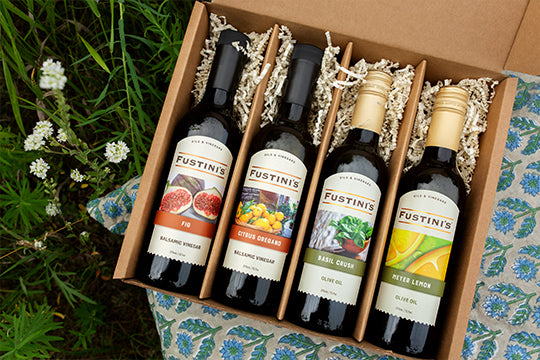Cooking Techniques: Your Guide to Emulsifying
Sweet and salty. Chicken and waffles. Chili and hot chocolate.
Sometimes, two things that don’t go together can make something truly wonderful.
There’s also a cooking technique that brings together two ingredients with different consistencies and properties to make a sauce or condiment that leaves your tastebuds delighted.
The process is called emulsification. It’s what happens when you combine an oil and a water-based liquid like balsamic and can be a great cooking technique in creating creamy dressings and thick sauces.
How Does an Emulsification Work?
An emulsification is based on the foundation that water and oil don’t mix. While the word may sound technical and science-y, the concept is quite simple.
When you shake or whisk the two together, they seem to be able to combine. If you’ve never tried it before, take out a jar and combine a little bit of water and oil into the jar. Then shake. For a period of time, it’ll look like they’ve blended well. However, after just a little bit of time, the two ingredients begin to separate. This is called a colloidal suspension. Basically, the force of shaking or whisking has broken down the oil into small bits and are suspended in the water, but only temporarily.
When you use an extra virgin olive oil and balsamic vinegar, the mixture actually stays together much better than when using other types of oil and distilled vinegar. Just another reason to pick up your favorite bottles of each.
Also when you emulsify, you can bring in another ingredient to keep those oil particles suspended in that water-based substance. This ingredient works well with both oil and water to unite them together happily.
Variety of Emulsifiers
Depending on what you’re looking to make, there are different kinds of emulsifiers that provide additional flavor and keeps all ingredients together. For example, hollandaise and aiolis are often held together with egg yolk, as is mayonnaise due to its protein properties. For vinaigrettes, mustard is a common choice that balances both ingredients well. Two other emulsifiers you might want to try include honey and garlic paste that can amp up your dressing or sauce and keep the mixture together.
All About Speed
A key in successfully emulsifying is the speed in whisking the ingredients together. The whisking (or stirring or shaking) provides the force that makes the oil particles break down and remain suspended in the vinegar. Be mindful of the speed of mixing and how fast you add each ingredient.
If you emulsion breaks, or remains separated, usually adding a little bit of water can help, as well as readjusting the ingredients. Using a blender also can help you fix your emulsion.
What Can You Do With Emulsifying?
The beauty of emulsification is that it allows you to disperse your flavorful sauce or dressing over your food quickly and evenly. This is the process in creating a cohesive vinaigrette for your salad or fruit.
Vinaigrettes
When it comes to adding the finishing touch to your salad creation, the dressing you choose is important. This is the flavor that brings all other ingredients together. And, creating a vinaigrette involves the process of emulsification. The ratio of oil to vinegar, to other ingredients such as an emulsifier, depends on your particular taste preferences. Often, people use the ratio of three parts oil to one part balsamic. However, you’re free to adjust the amount of each you put in.
To help you get started, check out this Basil-Lime Salad Dressing or this Caribbean Honey Citrus Vinaigrette for your next lunch or dinner side.
Sauces
When it comes to amping up the flavor of your meats, veggies and more, you can pair an easy-to-make sauce for your dish. When you think specifically of incorporating an emulsion into a sauce, there are a few that have become staples of this technique. Hollandaise sauce, for example, is a common emulsification used in French cuisine that uses egg yolk as an emulsifier.
Get to Emulsifying
When you first start venturing into emulsifications, don’t be discouraged if it doesn’t turn out perfectly right away. Due to the important balance of the ingredients involved, it takes intentionality and patience.
When it comes to making an emulsification, the key is to add the oil slowly into the mixture with the vinegar and emulsifier. Too fast and the oil and vinegar will want to stay separated. Also pay attention to the temperature of your emulsifier to ensure it’s not too hot or too cold compared to the oil and vinegar.
With these tips and recipes to get you started, you can be on your way to trying this fun cooking technique you can use from salads to meats to veggies to so much more. So grab your whisk and get to emulsifying.






